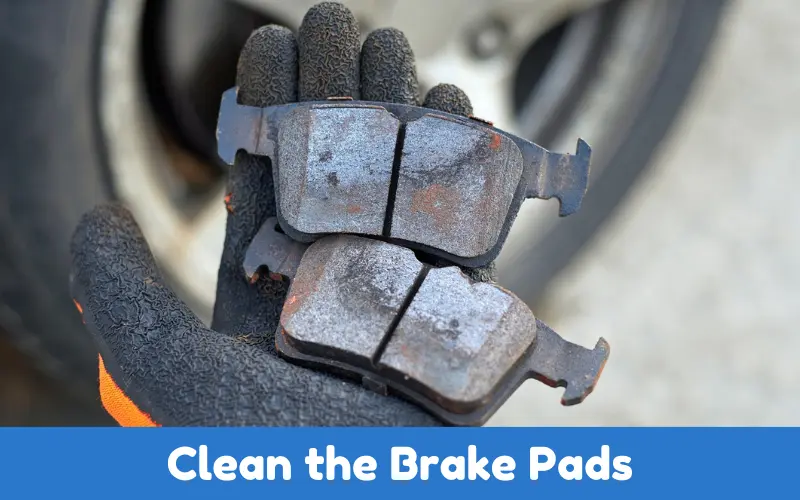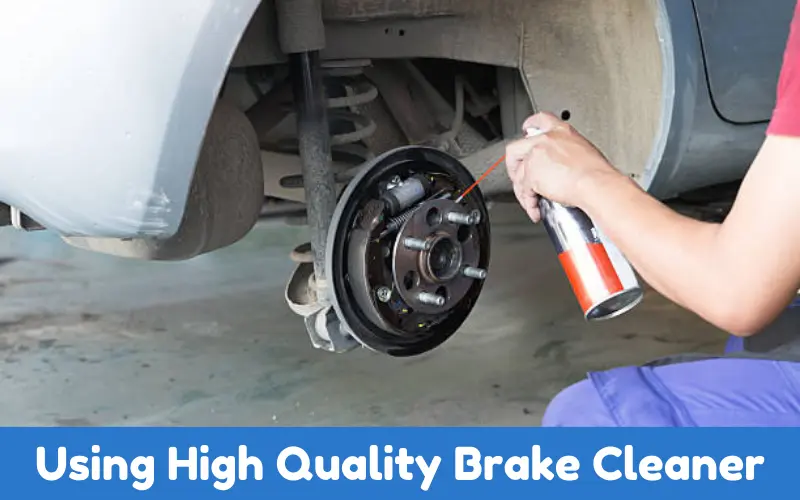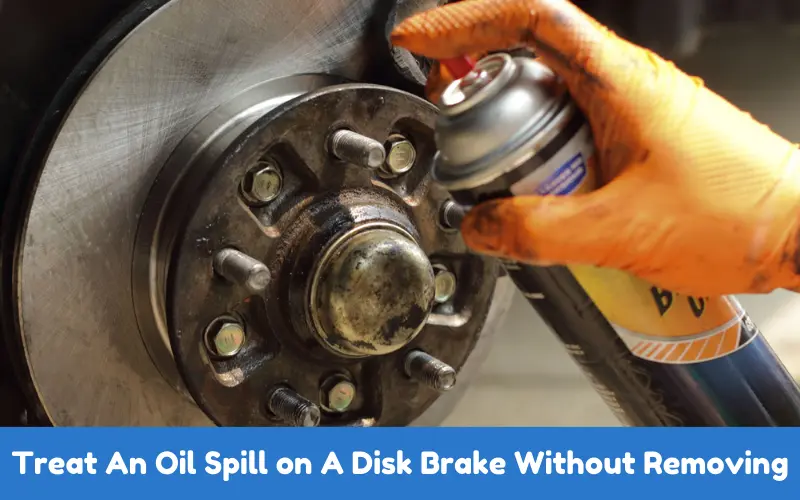Cleaning oil from disk brakes is essential to ensure the brake performance remains safe. Oil on the brakes will reduce friction and brake performance, and it can be potentially dangerous to drive your car like that.
In an optimal situation, you have to remove the brake components to clean your brake components separately to make sure you clean all the parts that are contaminated.
But in some cases, there is a need to have a quick fix without the option of disassembling the brake components. In this tutorial, we will demonstrate how to treat an oil spill on a disk brake without removing it.
Topic Summary
- How To Treat An Oil Spill on A Disk Brake Without Removing?
- What Do You Do If You Get Oil on Disc Brakes?
- FAQS About How To Treat An Oil Spill on A Disk Brake Without Removing
- Can I Clean the Oil Off My Disk Brakes Without Removing the Brake Components?
- What Type of Cleaner Should I Use To Remove Oil From Brakes?
- How Do I Know If My Brakes Are Still Contaminated After Cleaning?
- What Should I Do If A Leak Causes Oil Contamination?
- Is It Safe To Drive After Cleaning Oil Off My Brakes Without Removing Them?
- Conclusion
How To Treat An Oil Spill on A Disk Brake Without Removing?
You made an oil spill on your upper or lower disc brake, and now it is time to clean it. The problem is that you are in a rush and don’t want or need to remove any component.
Some people are very protective of their brake pads! Whether you just spilled oil on the disc brake pedestal, rotor, or brake pad, each solution requires different steps.
We will provide you with clear step by step instructions on how to handle an oil spill on your upper or lower disc brake without removing it. Just follow these easy steps below.
1. Safety First
First, make sure the vehicle you are working on is parked on a flat, level surface, and the engine is turned off.
To reduce the possibility of the vehicle rolling or shifting while you work, set the parking brake and, if you can, use wheel chocks.
Always wear work gloves and safety glasses to protect your skin and eyes from hazardous fluids.
2. Identify the Affected Area
The first thing I do is check out the brakes to see what looks soaked, checking the brake rotors, the brake calipers, and the brake pads.
Then, it depends on how much contamination and how many components have been involved. If the oil has spread all over, you might have to clean everything again.
3. Clean the Rotor Surface
To clean the rotor surface without removing it, follow these steps:
Use a Brake Cleaner: Use a quality brake cleaner. This special product works by being sprayed directly onto the rotor.
Brake cleaner evaporates quickly when applied, and when it does, it removes oil residue from it, leaving nothing behind.
Make sure you get every area of the rotor sprayed, but pay special attention to any areas where the oil is most visible.
Wipe with a Clean Cloth: After you have sprayed, wipe with a clean, lint free cloth, leaving behind the much smaller amount of artistic oil and brake cleaner residue that actually contacts it.
Make sure the clean cloth you use is not actually dirty and devoid of grease. Using a dirty or grease-coated cloth is recontaminating it.
Repeat if Necessary: Repeat the rinse and spin cycles if the rag smells of oil.
4. Clean the Brake Pads
While it’s usually easiest to remove the brake pads in order to clean them, this isn’t always necessary.
As shown here, it’s possible to do a decent job of cleaning brake pads without removing them, although this takes some extra attention.
Spray Brake Cleaner: Spray the brake cleaner on the brake pads. They are somewhat porous, so they can absorb oil. When spraying, make sure that the cleaner penetrates the material.

Let it Soak: Let the brake cleaner soak into the pads for a few minutes, and the oil within will dissolve.
Wipe Off Excess Cleaner: Use a clean rag or paper towel to remove the excess brake cleaner and oils. Wipe it off as best as possible, and do not let it sit there.
Test for Effectiveness: Gently press the brake pedal several times to ensure that the pads are able to engage the rotor. If the stopping is still slippery and/or unpredictable, rinse and repeat, or replace the pads if they’re really dirty.
5. Inspect for Leaks
Check to see where the oil came from, then drain the brakes and figure it out. Sometimes, oil can leak through a bad brake line or because someone is going through their stop fuel.
More often, they leak in from somewhere else because you have a bad wheel bearing seal where the bearing fits into the hub, or the seal on your engine or transmission failed, and oil has worked its way in.
You need to fix the place where it’s actually coming from. The oil itself doesn’t just coat your brakes nearly as fast as brake fluid or grease does, but it can get in the way.
6. Test Your Brakes
After cleaning, go for a brief, cautious spin in a safe place while applying the brakes several times gently to ensure you have cleaned them properly.
If the brakes operate normally, with no squeaking or squawking and the same level of stopping power, then the cleaning has worked.
However, the issues persist, you will need to remove the parts for more aggressive cleaning or outright replacement.
7. Prevent Future Contamination
In order to not have an oil spill in your disk brakes again, check your vehicle periodically for leaks and keep your braking system clean.
Be careful when you need to do some maintenance task involving oil or fluids in the area of the braking system, and make sure that if it spills, it is cleaned up right away.
What Do You Do If You Get Oil on Disc Brakes?
If you get oil on your disc brakes, it’s important to act quickly before you compromise your braking performance. The first step is to park in a safe place on a level surface and turn off the engine.
Using a high quality brake cleaner, spray the product directly onto the contaminated rotor and pads.

Brake cleaner is formulated to rapidly evaporate without leaving any oily residue. Following the application, use a clean, lint-free cloth to wipe down the rotor.
When it comes to the pads, spray generously and let the product soak for a few minutes before wiping away any excess.
Then, check around the brakes to make sure all traces of oil are gone. If the brakes are still sticky or unresponsive, repeat the cleaning process.
Be sure to test drive the car slowly after your repair to make sure the brakes are working right.
If the issue persists, have it looked at by a professional mechanic or replace the brake pads to prevent further damage or an accident.
FAQS About How To Treat An Oil Spill on A Disk Brake Without Removing
Can I Clean the Oil Off My Disk Brakes Without Removing the Brake Components?
Yes, oil can be removed from disk brakes without taking them apart. Ideally, you’d use brake cleaner, which is designed to evaporate quickly and will clean off oil and other contaminants so that they don’t remain as a residue. However, for contamination that’s really nasty, it might make sense to take these components apart and do a deeper cleaning.
What Type of Cleaner Should I Use To Remove Oil From Brakes?
Disk brakes call for a good brake cleaner in order to get them clean of oil, which is formulated to dissolve and remove oil, grease, and contaminants without damaging brake components and without leaving behind a residue.
How Do I Know If My Brakes Are Still Contaminated After Cleaning?
After cleaning, you should test the brakes for proper operation. To do this, gently pump the brake pedal and try stopping the car. The brakes should feel normal. There shouldn’t be any slipping, reduced stopping power, or unusual noise. If the brakes still feel bad, you should clean the brakes again. If the brakes still don’t feel right, you might have to remove the brake pads and either clean or replace them.
What Should I Do If A Leak Causes Oil Contamination?
While a leak is one possible explanation (and should be treated in the same way), it’s important to address the actual source of the oil to ensure the contamination doesn’t return, which could be as simple as a leaking brake fluid or wheel bearing seal, or as serious as a leaking engine oil. Fix the source to keep your brakes clean and effective.
Is It Safe To Drive After Cleaning Oil Off My Brakes Without Removing Them?
Then, you clean them up and test them in an environment that allows you to keep control before driving in normal traffic. If your brakes feel responsive and there is no slipping or reduced ability to stop, you are probably OK. If you’re not sure, take it to a mechanic for a complete check.
Conclusion
An oil spill on disk brakes may be treated without brakes being removed with the right instruments and the care of the motorist.
With the brake cleaner sprayed into the bleeder valve, all spaces and nooks for oil within the bore are flooded and overflowed back into the fluid reservoir after the car is parked and the brakes applied.
It is advisable in some cases where brakes have been contaminated badly or aren’t improving with cleaning to consult an expert mechanic so as not to compromise the safety of your braking function.

